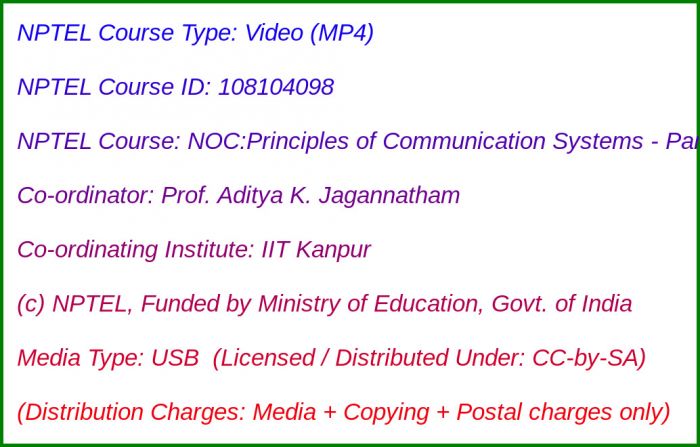NOC:Principles of Communication Systems: Part-II (USB)

Media Storage Type : 32 GB USB Stick
NPTEL Subject Matter Expert : Prof. Aditya K. Jagannatham
NPTEL Co-ordinating Institute : IIT Kanpur
NPTEL Lecture Count : 56
NPTEL Course Size : 3.1 GB
NPTEL PDF Text Transcription : Available and Included
NPTEL Subtitle Transcription : Available and Included (SRT)
Lecture Titles:
Lecture 1 - Introduction to Digital Communication Systems
Lecture 2 - Spectrum of Transmitted Digital Communication Signal and Wide Sense Stationarity
Lecture 3 - Spectrum of Transmitted Digital Communication Signal, Autocorrelation Function and Power Spectral Density
Lecture 4 - Spectrum of Transmitted Digital Communication Signal, Relation to Energy Spectral Density and Introduction to AWGN Channel
Lecture 5 - Additive White Gaussian Noise (AWGN) Properties, Gaussian Noise and White Noise
Lecture 6 - Structure of Digital Communication Receiver, Receiver Filter and Signal-to-Noise Power Ratio (SNR)
Lecture 7 - Digital Communication Receiver, Noise Properties and Output Noise Power
Lecture 8 - Digital Communication Receiver, Optimal SNR and Matched Filter
Lecture 9 - Probability of Error in Digital Communication and Probability Density Functions of Output
Lecture 10 - Probability of Error in Digital Communication, Optimal Decison Rule and Gaussian Q function
Lecture 11 - Introduction to Binary Phase Shift Keying (BPSK) Modulation, Optimal Decision Rule and Probability of Bit-Error or Bit-Error Rate (BER)
Lecture 12 - Introduction to Amplitude Shift Keying (ASK) Modulation
Lecture 13 - Optimal Decision Rule for Amplitude Shift Keying (ASK), Bit Error Rate (BER) and Comparison with Binary Phase Shift Keying (BPSK) Modulation
Lecture 14 - Introduction to Signal Space Concept and Orthonormal Basis Signals
Lecture 15 - Introduction to Frequency Shift Keying (FSK)
Lecture 16 - Optimal Decision Rule for FSK, Bit Error Rate (BER) and Comparison with BPSK, ASK
Lecture 17 - Introduction to Quadrature Phase Shift Keying (QPSK)
Lecture 18 - Waveforms of Quadrature Phase Shift Keying (QPSK)
Lecture 19 - Matched Filtering, Bit Error Rate and Symbol Error Rate for Quadrature Phase Shift Keying (QPSK)
Lecture 20 - Introduction to M-ary PAM (Pulse Amplitude Modulation), Average Symbol Power and Decision rules
Lecture 21 - M-ary PAM (Pulse Amplitude Modulation) -Part-II, Optimal Decision Rule and Probability of Error
Lecture 22 - M-ary QAM (Quadrature Amplitude Modulation) Part-I, Introduction, Transmitted Waveform and Average Symbol Energy
Lecture 23 - M-ary QAM (Quadrature Amplitude Modulation) - Part-II, Optimal Decision Rule, Probability of Error and Contellation Diagram
Lecture 24 - M-ary PSK (Phase Shift Keying) Part-I, Introduction , Transmitted Waveform and Constellation Diagram
Lecture 25 - M-ary PSK (Phase Shift Keying) - Part-II, Optimal Decision Rule, Nearest Neighbor Criterion and Approximate Probability of Error
Lecture 26 - Introduction to Information Theory, Relevance of Information Theory and Characterization of Information
Lecture 27 - Definition of Entropy, Average of Information / Uncertainity of source and Properties of Entropy
Lecture 28 - Entropy Example- Binary Source Maximum and Minimum Entropy of Binary Source
Lecture 29 - Maximum Entropy of Source with M-ary Alphabet, Concave/Convex Functions and Jensens Inequality
Lecture 30 - Joint Entropy , Definition of Joint Entropy of Two Sources and Simple Examples for Joint Entropy Computation
Lecture 31 - Properties of Joint Entropy and Relation between Joint Entropy and Marginal Entropies
Lecture 32 - Conditional Entropy, Example of Conditional Entropy and Properties of Conditional Entropy
Lecture 33 - Mutual Information, Diagrammatic Representation and Properties of Mutual Information
Lecture 34 - Simple Example of Mutual Information and Practical Example of Mutual Information-Binary Symmetric Channel
Lecture 35 - Channel Capacity, Implications of Channel Capacity, Claude E. Shannon- Father of Information Theory and Example of Capacity of Binary Symmetric Channel
Lecture 36 - Differential Entropy and Example for Uniform Probability Density function
Lecture 37 - Differential Entropy of Gaussian Source and Insights
Lecture 38 - Joint Conditional/ Differential Entropies and Mutual Information
Lecture 39 - Capacity of Gaussian channel - Part I
Lecture 40 - Capacity of Gaussian Channel - Part-II, Practical Implications and Maximum rate in bits\sec
Lecture 41 - Introduction to Source Coding and Data Compression, Variable Length codes and Unique Decodability
Lecture 42 - Uniquely Decodable Codes, Prefix-free code, Instantaneous Code and Average Code length
Lecture 43 - Binary Tree Representation of Code, Example and Kraft Inequality
Lecture 44 - Lower Bound on Average Code Length and Kullback-Leibler Divergence
Lecture 45 - Optimal Code length, Constrained Optimization and Morse Code Example
Lecture 46 - Approaching Lower Bound on Average code length and Block Coding
Lecture 47 - Huffman Code, Algorithm, Example and Average Code Length
Lecture 48 - Introduction to channel coding, Rate of Code, Repetition Code and Hamming Distance
Lecture 49 - Introduction to Convolutional Codes, Binary Field Arithmetic and Linear Codes
Lecture 50 - Example of Convolutional Code Output and Convolution Operation for Code generation
Lecture 51 - Matrix Representation of Convolutional Codes, Generator Matrix, Transform Domain Representation and Shift Register Architecture
Lecture 52 - State Diagram Representation of Convolutional Code, State transitions and Example of Code Generation using State transitions
Lecture 53 - Trellis Representation of Convolutional Code and Valid Code Words
Lecture 54 - Decoding of the Convolutional Code, Minimum Hamming distance and Maximum Likelihood Codeword Estimate
Lecture 55 - Principle of Decoding of Convolutional code
Lecture 56 - Viterbi Decoder for Maximum Likelihood Decoding of Convolutional Code Using Trellis Representation, Branch Metric Calculation, State Metric Calculation and Example

